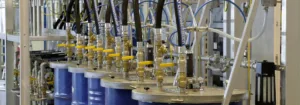Updated 26/08/2025
Air motors—also known as pneumatic motors or compressed air engines—are widely used in industrial applications where durability, safety, and versatility are essential. Unlike electric motors, an air motor converts the energy of compressed air into rotational or linear motion, making it an efficient choice for challenging environments.
This guide explains:
The design principles of air motors
How an air motor works step by step
The different types of air motors
Key performance factors like speed, pressure, and lubrication
What Is an Air Motor?
An air motor is a device that generates mechanical power by expanding compressed air. It is compact, lightweight, and reliable in environments where heat, sparks, or contamination could make electric motors less suitable.
Air Motor Design Basics
Air motors come in several designs—vane, piston, gear, and turbine—but the most common and versatile type is the vane motor, capable of power ratings up to 5 kW.
Core Components of a Vane Air Motor
Cylinder and end plates: Form the main body (the chamber).
Rotor: Positioned slightly off-center, creating a crescent-shaped chamber.
Vaned rotor slots: Vanes divide the chamber into smaller, sealed working chambers.
Centrifugal force + compressed air: Pushes the vanes outward, ensuring a tight seal and efficient energy transfer.
This simple yet effective design ensures smooth performance and long service life.
How Does an Air Motor Work? (Step by Step)
Air Intake: Compressed air enters the inlet chamber.
Pressure Build-Up: The air pressure pushes against the vanes in the rotor.
Expansion: As the vanes rotate, chambers expand and contract, converting air pressure into motion.
Exhaust: Used air exits through the outlet.
Mechanical Motion: The rotor’s movement generates rotational force, which can be geared for the application’s needs.
👉 In short: compressed air → expansion → vane movement → rotation → usable power.
Design and Performance Factors
Rotor Speed: High-speed motors may experience vane wear; longer, slimmer rotors with fewer vanes reduce friction.
Number of Vanes: Fewer vanes = less friction; more vanes = easier starting and less leakage.
Gears: Convert high-speed, low-torque output into lower-speed, higher-torque performance.
Lubrication: Traditional motors require oil, but Atlas Copco vane motors are lubrication-free thanks to advanced materials and bearings.
Types of Air Motors
Vane Air Motors – Most common; simple, efficient, versatile.
Piston Air Motors – Use pistons to generate motion; ideal for high torque.
Radial piston motors: Multiple pistons arranged around a shaft.
Axial piston motors: Pistons aligned with the shaft.
Gear Air Motors – Use gears to transform compressed air into motion.
Turbine Air Motors – High-speed rotation using a turbine wheel.
Air Motor Speed and Pressure Control
Air motors can be easily controlled without complex electronics:
Air Flow Control: Adjust compressed air volume to set speed.
Pressure Regulation: Higher pressure = faster rotation; lower pressure = slower.
Valve Timing: In piston motors, timing adjustments can control direction and speed.
Typical operating pressures depend on the design and manufacturer specifications. Always consult the technical datasheet for optimal performance.
Why Choose an Air Motor?
Durability: Performs in harsh or explosive environments.
Versatility: Works in wet, dusty, or chemically aggressive conditions.
Compact power: High power-to-weight ratio compared to electric motors.
Safety: No sparks or overheating.
Frequently Asked Questions About Air Motors
What is the difference between an air motor and an electric motor?
An air motor (pneumatic motor) runs on compressed air, while an electric motor runs on electricity. Air motors are safer in explosive or wet environments, have a higher power-to-weight ratio, and can withstand stalling without damage. Electric motors, however, are often more energy-efficient in continuous operations.
What are the main types of air motors?
The most common types are:
Vane air motors – versatile and compact.
Piston air motors – high torque output, available in radial or axial configurations.
Gear air motors – durable with simple construction.
Turbine air motors – very high rotational speeds.
How efficient is an air motor?
Air motor efficiency depends on design, pressure, and load. While they are less energy-efficient compared to electric motors, they excel in durability, reliability, and controllability—especially where safety or compact power is critical.
Can an air motor run without lubrication?
Yes. Traditional vane motors require a small amount of oil, but modern lubrication-free air motors (like those from Atlas Copco) use advanced low-friction materials and permanently lubricated bearings to eliminate the need for oil.
What industries use air motors?
Air motors are widely used in:
Automotive assembly
Food and beverage processing (oil-free motors prevent contamination)
Pharmaceuticals
Mining and construction
Chemical plants and hazardous environments
How do you control the speed of an air motor?
Speed can be controlled by:
Adjusting the airflow with a flow control valve.
Regulating the air pressure supplied to the motor.
Changing valve timing (mainly in piston air motors).
What pressure do air motors need?
Most air motors operate efficiently in the range of 4–7 bar (60–100 psi). The exact pressure range depends on the manufacturer and model, so it’s best to consult the product datasheet for precise specifications.
Conclusion
Air motors combine simple design with robust performance, making them essential in many industrial settings—from assembly lines to hazardous environments. Their ability to run reliably without sparks, overheating, or electrical hazards makes them an increasingly important choice for the future of industrial automation and sustainable manufacturing.
If you’d like expert advice on selecting the right air motor for your application, contact Atlas Copco for tailored recommendations.


